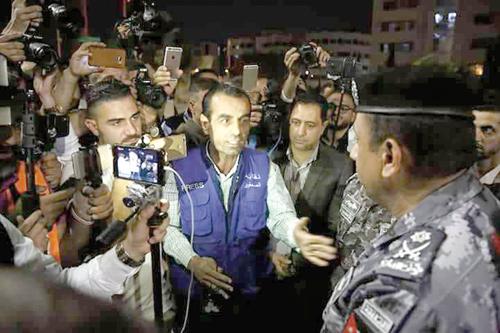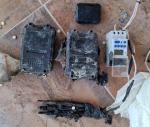You are here
Media coverage of Fourth Circle protests 'model' for future
By Ana V. Ibáñez Prieto - Jul 12,2018 - Last updated at Jul 12,2018

Journalists commend cooperation among police, protesters and journalists during popular protests (Photo courtesy of Khaled Qudah)
AMMAN — “The positive experiences of both local and international media covering the recent protests in Jordan shall serve as a model and a training case for all journalists working 'on the hot spot' in the future,” chair of the Jordan Press Association (JPA) Freedoms Committee Khaled Qudah said.
On the night of May 31st, thousands of Jordanians gathered in front of the Prime Ministry to protest the hikes in prices of fuel derivatives and electricity. Several other protests were held across the country rejecting the government's decision and the income tax draft law announced earlier.
The protests gained momentum after the government announced an increase of electricity prices by 23.5 per cent and fuel derivatives between 4.5 per cent to 5.5 per cent, citing the rise in prices of crude oil globally.
Road closures, burning tyres, chanting slogans calling on the government to step down and parking cars in the middle of main veins in Amman and several governorates were recorded, with reports of police intervention to bring the snowballing situation under control.
“But, in the middle of this chaos, local and international reporters witnessed for the first time fully organised journalism through a protest in Jordan,” Qudah told The Jordan Times, elaborating on how “a positive relationship was built among all protesters, media and security forces present in the protests at the Fourth Circle”.
Recalling the events as her first time covering a demonstration for an international media channel, journalist Dania Al Maayta told The Jordan Times "it was a great learning experience and I was able to work hard around the clock to deliver an unbiased picture of the uprising with no restrictions from any side”.
Comparing the experience with his time working in the UK, journalist Rabee Usbrahim shared a positive view of the climate of the protests, noting “what happened in Jordan when it comes to the mediation between the press and the police in the hot spot is common practice in Europe, with media coverage of the events in the Kingdom coming out as fairly acceptable when compared with neighbouring countries”.
“However, the reach and the impact of international media outlets provided us with a sort of unofficial immunity from restrictions when doing our job, while private local media appeared to be more subject to directions on where to stand and prior agreements with authorities aimed at keeping the media organised,” the journalist pointed out.
“Mediation was in place in order to keep all journalists safe when performing their tasks, and at the end of the events, not a single journalist was arrested, assaulted, prevented from covering or forced to delete a picture or video,” Qudah said, stressing that “the performance of the media professionals present at the protests held at the Fourth Circle have strengthened the status of local media institutions”.
In this regard, Al Maayta commended the role played by the JPA and the Freedoms Committee "through their constant presence in the field to facilitate the work of all media professionals".
“I have learned a lot from my daily presence on the lines between protesters, security forces and journalists,” Qudah said, expressing hopes to “turn this experience into a training programme to pass the knowledge attained in the field onto all media institutions in Jordan”.
“This is not just about journalists, but about all parties involved in situations of agglomeration to understand the mission of all sides and allow them to do their job without interruptions,” he added, suggesting the creation of a new code of conduct for journalists working on the hot spot based on the experience covering the protests.
Commenting on Qudah’s statements, Al Maayta expressed her wish for “more cooperation and coordination to facilitate our mission as journalists”, adding “there is no doubt that this is a requirement for development, and a code of conduct binding for all is key in the current media context”.
“There is always space to improve, and, despite the positive experience, it is undeniable that both police and journalists committed mistakes,” Usbrahim commented, showing his support for the creation of a media code of conduct. “This way, journalists would know exactly what to do in chaotic situations, bearing in mind that we are all here to depict the reality no matter to which extent we agree or disagree with the motives of a certain protest or demonstration,” he concluded.
Related Articles
AMMAN — The Jordan Press Association (JPA) said on Saturday it was following up on an alleged security personnel's attack against journalist
AMMAN — The Jordan Press Association's (JPA) council on Monday expressed its rejection of all measures that restrict the work of journalists
AMMAN – A new regulation by the Jordan Media Commission (JMC) is stirring controversy in media circles.Under a new decision made by the comm
















